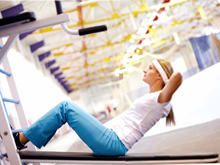Health Topics
-
Healthy Living
-
|
|
June 2011
|
| Basics For Your Back |
| Dr. Ashish Jaiswal |
| |
 |
If you want to strengthen your back, you really need to be working on your abdominal muscles in addition to the large trapezius muscle that covers the top of your back. To strengthen your back, you should combine a variety of muscle building exercises with excellent posture, so that you’re not undermining your efforts. |
Build Muscle
The first step to strengthening your back is to get approval from your doctor to begin a weight lifting routine – especially if you have prior back pain. Then, with your doctor’s approval, begin by working each set of muscles separately. You’ll need to increase strength throughout your trunk to fully support your back, so start at the top and work down.
Rowing and Swimming
Rowing and shoulder presses can help to strengthen the trapezius muscle. This is a large triangular muscle that extends from the back of your neck and shoulders, tapering down your spine. To build this muscle, you can work it vigorously with intense activities with a great deal of repetition. Swimming in general strengthens the back muscles and improves the muscle tone.
Abdominal Work
The muscles in the lower back are not as thick and strong as the trapezius, so you should be careful to not overexert your efforts. Your lower back is supported by bands of muscles that wrap around your back and sides.
Start with basic crunches and crunches across the body touching your elbow to your knee to build the large ab muscle and work a bit on the sides. Then use a machine or the guidance of a personal trainer to twist while holding weights effectively, using the side bands of muscle. Side bends with light weights will also help to strengthen the sides of the abdomen. Finally, dead lifts or carefully lifting weights from the floor to your knees will strengthen the muscles of your lower back.
Correct Sitting Position
- Sit up with your back straight and your shoulders back. Your buttocks should touch the back of your chair.
- All three normal back curves should be present while sitting. A small, rolled-up towel or a lumbar roll can be used to help you maintain the normal curves in your back.
- Bend your knees at a right angle. Keep your knees even with or slightly higher than your hips. (Use a foot-rest or stool if necessary). Your legs should not be crossed.
- Keep your feet flat on the floor.
- Try to avoid sitting in the same position for more than 30 minutes.
- At work, adjust your chair’s height and workstation so you can sit up close to your work and tilt it up at you. Rest your elbows and arms on your chair or desk, keeping your shoulders relaxed.
- When standing up from the sitting position, move to the front of the seat of your chair. Stand up by straightening your legs.Avoid bending forward at your waist. Immediately stretch your back by doing 10 standing backbends.
Correct Driving Position
- Use a back support (lumbar roll) at the curve of your back. Your knees should be at the same level or higher than your hips.
- Move the seat close to the steering wheel to support the curve of your back. The seat should be close enough to allow your knees to bend and your feet to reach the pedals.
Correct Lifting Position
- Always bend at the knees, not at the waist.
- Use the large leg and stomach muscles for lifting, not the lower back.
- If necessary, get a supportive belt to help maintain good posture while lifting.
- When carrying a heavy or large object, keep it close to the chest.
- If carrying something with one arm, switch arms frequently.
- When carrying a backpack or purse, keep it as light as possible, and balance the weight on both sides as much as possible, or alternate from side to side.
- When carrying a backpack, avoid leaning forward or rounding the shoulders. If the weight feels too much, consider using a rolling backpack with wheels.
The Best Position for Sleeping and Lying Down
- A relatively firm mattress is generally best for proper back support, although individual preference is very important.
- Sleeping on the side or back is usually more comfortable for the back, than sleeping on the stomach.
- Use a pillow to provide proper support and alignment for the head and shoulders.
- Consider putting a rolled-up towel under the neck and a pillow under the knees to support the spine better.
- If sleeping on the side, a relatively flat pillow placed between the legs will help keep the spine aligned and straight.
|
Indicators of more serious back problems warrant a need to seek medical help
- Changes in bladder and bowel control
- Loss of control of your legs
- Pins and needles or numbness around the saddle (genital or anal) area
- Pins and needles or numbness of both legs and feet
- Recent, unexplained weight loss
- Severe pain that comes on only at night
- Night sweats
- Major trauma such as vehicle accident or fall from a height
- Minor trauma, or even just strenuous lifting, in people with osteoporosis
- History of cancer
- Constitutional symptoms, e.g. fever, chills, unexplained weight loss
- Recent infection (e.g. bladder infection)
- Intravenous drug abuse
|
|
 |
Dr. Ashish Jaiswal is Spine Surgeon in Apollo Hospitals Bilaspur |
|
|